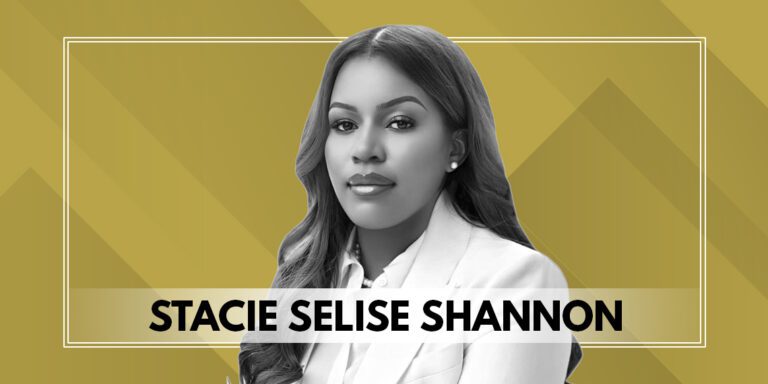Stacie Selise is a powerhouse leadership expert, speaker, and the Founder of The Stacie Selise Group, a boutique consulting firm that helps professionals and organizations elevate leadership from transactional to transformational. A former Fortune 20 Vice President who led award-winning teams across major markets, Stacie brings 15+ years of corporate leadership experience into her work with executives, teams, and emerging leaders. Through her signature 4S Framework by Stacie Selise™, she equips ambitious professionals with the mindset, strategy, and presence to lead with excellence. Known for blending real-world results with culture-shifting presence, Stacie is redefining what it means to lead with luxury, legacy, and power.
Company: The Stacie Selise Group
We are thrilled to have you join us today, welcome to ValiantCEO Magazine’s exclusive interview! Let’s start off with a little introduction. Tell our readers a bit about yourself and your company.
Stacie Selise Shannon: Thank you. I’m Stacie Selise Shannon, an executive leadership strategist, speaker, and founder of The Stacie Selise Group. After spending over a decade leading high-performing teams at a Fortune 20 company, I launched my firm to help ambitious professionals and organizations lead with greater impact and presence. The Stacie Selise Group is a consulting and advisory firm focused on elevating leadership from transactional to transformational. We offer a signature approach through The 4S Framework by Stacie Selise™, helping clients build strong teams, raise standards, and achieve measurable success. My work blends corporate experience with real-life results, and I’m proud to serve as a trusted voice for leadership excellence.
Can you share a time when your business faced a significant challenge? How did you navigate through it?
Stacie Selise Shannon: One of the most significant challenges was transitioning from a well-established executive role in corporate America to building my own consulting firm from the ground up. I was used to leading large teams with structure and systems already in place. As a founder, I had to create that infrastructure myself while also building brand trust. I focused on clear strategy, relationship-building, and consistent delivery of excellence. I leaned into my experience, trusted my instincts, and remained open to feedback. That season taught me that entrepreneurship requires both vision and discipline.
How has a failure or apparent failure set you up for later success?
Stacie Selise Shannon: Earlier in my career, I took on a leadership role where the cultural alignment just wasn’t there. I pushed through for a while, but the experience left me drained and disconnected. Stepping away gave me the perspective I needed to define what matters most in my work: people-first leadership, authentic communication, and mission-driven results. That experience helped shape the foundation of The Stacie Selise Group. What once felt like a misstep turned into the catalyst for building something aligned, impactful, and powerful.
How do you build a resilient team? What qualities do you look for in your team members?
Stacie Selise Shannon: Resilience starts with trust. I build teams by creating a safe space where people can contribute fully and fail forward without fear. I look for integrity, adaptability, self-awareness, and a hunger to grow. Skills can be taught. Character and accountability are what truly make someone an asset to the team.
How do you maintain your personal resilience during tough times?
Stacie Selise Shannon: I come back to my purpose. When challenges hit, I remind myself why I started and who I’m building for. I also rely on routines that keep me grounded. That includes spiritual alignment, movement, staying connected to my circle, and taking breaks when needed. Resilience doesn’t mean doing it all. It means knowing when to pause so you can keep going with power.
What strategies do you use to manage stress and maintain focus during a crisis?
Stacie Selise Shannon: I get still. I start each morning with a calm reset, even if that means waking up earlier to protect my peace. I also break big problems into manageable pieces and focus on what I can control. I eliminate distractions and give myself permission to step away when my mind feels cluttered. Presence is key to progress.
How do you communicate with your team during a crisis?
Stacie Selise Shannon: With directness, consistency, and care. I make sure no one is left guessing and never assume we’re all aligned without checking in. I state the facts, acknowledge concerns, and keep our focus on what we’re here to accomplish. Trust is built through honest and steady communication, especially when things are uncertain.
What advice would you give to other CEOs on building resilience in their organizations?
Stacie Selise Shannon: Don’t just lead through performance. Lead through people. Resilient organizations are built on strong culture, empowered teams, and leaders who know how to stay calm under pressure. Build systems that allow flexibility, invest in leadership development, and always keep your mission front and center.
How do you prepare your business for potential future crises?
Stacie Selise Shannon: I plan proactively, not reactively. That means documenting systems, diversifying income streams, and maintaining strong relationships with my team and clients. I also invest in continued learning so I can make decisions quickly when conditions shift. Crisis is never convenient, but preparation makes all the difference.
What’s the most important lesson you’ve learned about leadership in times of crisis?
Stacie Selise Shannon: Your team is watching you more than they’re listening to you. Leadership in crisis is not just about solving the problem. It’s about how you show up while solving it. Your tone, your energy, and your steadiness create the emotional blueprint for how others will respond. You don’t have to have all the answers, but you do need to be anchored.






